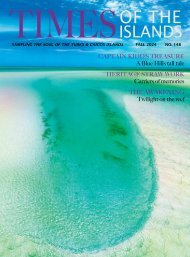Times of the Islands Winter 2018/19
Presents the "soul of the Turks & Caicos Islands" with in-depth features about local people, culture, history, environment, businesses, resorts, restaurants and activities.
Presents the "soul of the Turks & Caicos Islands" with in-depth features about local people, culture, history, environment, businesses, resorts, restaurants and activities.
- No tags were found...
Create successful ePaper yourself
Turn your PDF publications into a flip-book with our unique Google optimized e-Paper software.
This image explains <strong>the</strong> concepts <strong>of</strong> sea breeze and cloud formation.<br />
erally blow from high pressure towards lower pressure,<br />
which during <strong>the</strong> day is from <strong>the</strong> ocean to <strong>the</strong> land. At<br />
night, we normally see <strong>the</strong> reverse situation—winds blowing<br />
from land out to sea.<br />
One final factor that will play into cloud formation<br />
has to do with <strong>the</strong> amount <strong>of</strong> moisture in <strong>the</strong> air. And<br />
we know based on geographic location that <strong>the</strong>re is an<br />
abundance <strong>of</strong> moisture in <strong>the</strong> atmosphere generally at all<br />
times over <strong>the</strong> <strong>Islands</strong>.<br />
Now let’s discuss <strong>the</strong> “hows” <strong>of</strong> cloud formation.<br />
Clouds are a conglomeration <strong>of</strong> trillions and trillions <strong>of</strong><br />
molecules <strong>of</strong> water vapor. Generally unseen to <strong>the</strong> naked<br />
eye, yet felt on <strong>the</strong> skin as humidity, water vapor once<br />
compacted into large areas reveals itself as clouds.<br />
How is it we see <strong>the</strong>se clouds? In <strong>the</strong> Caribbean, we<br />
can thank <strong>the</strong> salt in <strong>the</strong> ocean for this! In order to see<br />
clouds, we depend on what is called Cloud Condensation<br />
Nuclei, abbreviated as CCN. These are particles <strong>of</strong> dust,<br />
salt, pollution, and even sand from <strong>the</strong> Saharan Desert.<br />
Water vapor by nature, will need something to condense<br />
to in order for us to see it visibly. These CCN stick to<br />
water vapor, which is <strong>the</strong> single most important item we<br />
need for cloud formation. For <strong>the</strong> <strong>Islands</strong>, salt water evaporates<br />
<strong>of</strong>f <strong>the</strong> surface <strong>of</strong> <strong>the</strong> ocean and rises into <strong>the</strong> air<br />
as <strong>the</strong> CCN needed. However in order to see <strong>the</strong>se as<br />
clouds we need something else to occur.<br />
During <strong>the</strong> day, as <strong>the</strong> land heats up and low pressure<br />
develops over <strong>the</strong> land, <strong>the</strong> warm air rises in convective<br />
currents <strong>of</strong>f <strong>the</strong> hot ground into <strong>the</strong> air above <strong>the</strong> <strong>Islands</strong>.<br />
As <strong>the</strong> winds blow <strong>of</strong>f <strong>the</strong> water and arrive on land, <strong>the</strong>y<br />
get naturally deflected up as <strong>the</strong>y encounter topography<br />
and <strong>the</strong> much warmer air that is also rising. As this wind<br />
and air rises, it naturally begins to cool once again. And<br />
as that air cools, it also condenses. Those trillions <strong>of</strong><br />
molecules <strong>of</strong> water vapor become visible as tiny water<br />
droplets. And in mass, <strong>the</strong>y are visible as <strong>the</strong> fluffy white<br />
clouds we see across <strong>the</strong> <strong>Islands</strong>.<br />
If you would like to see this in action on a smaller<br />
scale, boil a pot <strong>of</strong> water on <strong>the</strong> stove. As <strong>the</strong> water boils,<br />
Grand Slam <strong>Times</strong> <strong>Winter</strong> <strong>2018</strong>_Layout 1 11/14/18 8:36 PM Page 1<br />
Operating Provo’s Most Famous Vessels<br />
GWENDOLYN, TUNA-IN and WAHOOOOO<br />
See it all at: www.gsfishing.com<br />
CONTACT US: 1-649-231-4420 • info@gsfishing.com<br />
Free Pickup • Drinks and Snacks Included<br />
Catch and Keep Your Fish!<br />
Quote Booking: TOI 002 for 5% Discount...<br />
Ask your Concierge to book online for you!<br />
<strong>Times</strong> <strong>of</strong> <strong>the</strong> <strong>Islands</strong> <strong>Winter</strong> <strong>2018</strong>/<strong>19</strong> 15

















